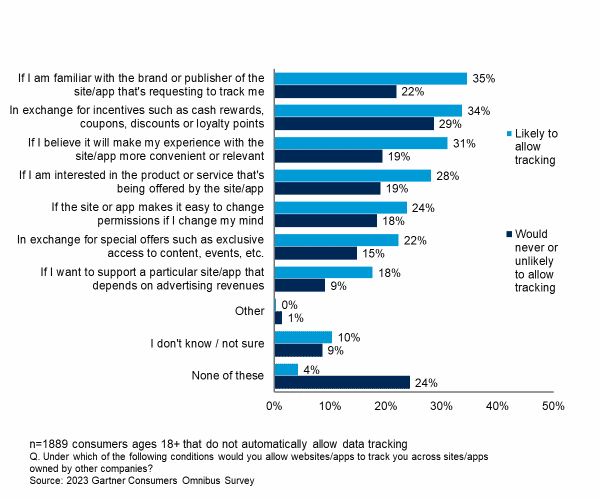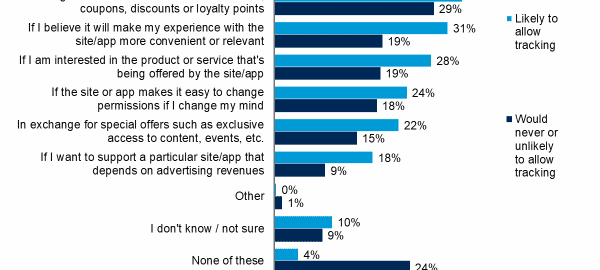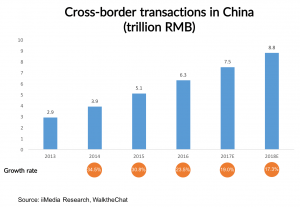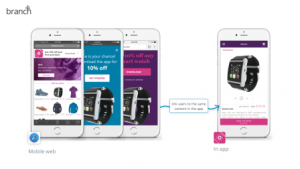Uncover how brand perception and incentives shape customer data-sharing decisions, plus tips for balancing trust and ROI.
This article was co-authored with Dan Gutter, Sr. Research Specialist, covering Consumer and Culture Insights in the Gartner Marketing Practice.
Marketing leaders looking to expand their customer database should focus on delivering value to the customer as the top priority in their strategies and campaigns — or risk undermining their customer data exchange efforts and investments.
Today’s consumers are taking a more active approach to withholding their personal data. One-third of consumers use app and system settings to deny data consent, per a 2023 Gartner survey. This is a shift in behavior from 2021 when consumers were more likely to simply abandon apps or sites that asked for permission to track and collect data.
Consumers are wary about sharing their data, with only a quarter typically granting online tracking permission. Still, the growing use of data avoidance strategies, rather than outright abandonment, could offer opportunities for marketers.
The balancing act of customer data value exchange and ROI
Marketing leaders must find the right balance between the value of enhanced customer data and the cost of incentivizing the customer to share the data. This adds nuance to the existing cost per acquisition or cost per action formula.
Traditional marketing campaigns are typically assessed based on returns like engagement, conversions, perception, and acquisition. However, in today’s data-conscious environment, the cost of incentives is a key factor to consider.
Gartner research has shown that customers who sit on the data-sharing fence can be influenced to provide more in exchange for the right value. Of those consumers unlikely to allow brands to track their personal data, 67% could be open to changing their tune — given the right conditions.
Specific conditions where consumers are most likely to change their minds and allow data tracking include:
- If they are familiar with the brand/publisher.
- If they are incentivized by cash rewards, coupons, discounts or loyalty points.

The value of brand perception
Brand familiarity is critical for changing the minds of customers who usually reject tracking. It’s vital to connect your brand perception efforts to your customers’ willingness to share data. This involves ensuring current and potential customers understand the benefits of data collection at every stage.
For example, certain retailers can provide a loyalty program with clear purchase-based rewards and additional perks tied to sharing personal data, such as birthday freebies.
Now more than ever, there is a direct link between brand and customer data acquisition success. After all, who today would willingly share data with a brand whom they didn’t trust or were not familiar with?
The value of incentives
Incentivization is the next frontier of influence. It can fall into a few main categories, including:
- Exclusive content.
- Rewards.
- Coupons.
- Discounts.
- Loyalty points.
To determine the optimal investment for incentivization, a marketing program must first assess the worth of customer data at:
- The record level (think customer lifetime value).
- The dimension level (think the value of knowing intent or product preference).
Most organizations lack this knowledge, but making effective incentive decisions relies on it. Leading companies build that knowledge by using a hypothesis-led, iterative test-and-learn approach to campaigns incentivizing data exchange.
The value of experience
Incentivization is important to explore, but it varies in utility depending on the business model. Don’t lose sight of the influence that the prospect of a more convenient or relevant experience might bring. This was the third most valued condition for data exchange, followed by the perception of ease in managing permissions.
To convey the value of better customer experiences when asking for data, you must understand the specific customer journey moment and the tangible benefits customers will receive should they decide to share.
In speaking with marketing leaders, they emphasize the vital role of experimentation in developing a strong customer data strategy. Understanding the most effective methods of influence for different customers, touchpoints and journey contexts requires a proactive test-and-learn approach.
An organization’s competitive advantage in marketing lies in its ability to create and test clear hypotheses about the value of customer data exchange.
The post Putting customers first: The key to successful customer data exchange appeared first on MarTech.
(24)
Report Post








